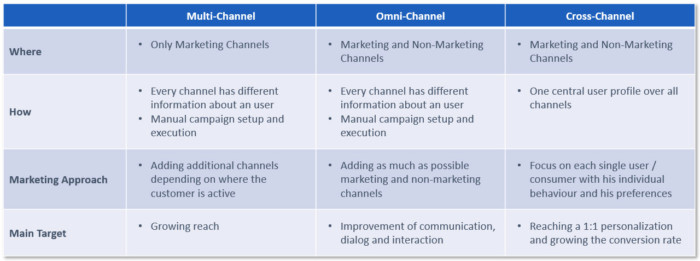
There is light which guides us on the right way. While we are in our day-to-day business there is something going on in the background. The role and acting between a company and the customer is changing… through every business and all industries.
While we are often full-time in many operating projects, we have to keep an eye on how we as a company wants to be in our market in 5, 10 or more years. There are things to consider to steer the boat in the wild and changing water. It is not only about the vision which is far away, it is also how to enable the vision by what we are doing today.
Let’s have a deeper look in this article into the different players and areas.
| 1. The Customer | 4. The Transformation |
| 2. The Company | 5. The Conclusion |
| 3. The Silos |
It will be just a very short snapshot, but think of the core behind and leave the “but” out of your thoughts. Maybe it’s a bit theoretical in a first view. However, I think we (including me) are sticking to often in details and bits & bytes. We are just looking on the next foot step and losing the path and the target out of our focus. Maybe we are focusing just on the next milestone as our target while there is a transformation in place which is much more than the next milestone.
The Customer
Customers are getting more and more power and the pressure to be more customer centric is growing. Directly or indirectly customers are sharing data and show their interest, their interest / need / pain and their attitude at the moment of time.
How did we act in the past with a customer?
– We sent out a newsletter to all 20 thousand recipients… 1:all.
– We showed ads based on what someone clicked (in the past)…. we all know how annoying re-targeting is.
How do we act in future with a customer?
– We send out mails not as a newsletter in a 1:many format, we send it out 1:1 at the moment of time and if we have usable or meaningful information for someone.
– The past is gone, we understand the moment of time and show what is needed now and what is the next thing (future). This is showing respect against our customer and gaining trust through this.

90% of what companies are doing in their communication (newsletter, website, Facebook page, etc.) is, that they deliver useful content… but do to the fact that it isn’t customized on a 1:1 base, it’s most of the time not usable for me as a customer (user) at the moment I’m watching it, it is just “nice”.
What we need is a transformation from “useful need” to “usable need”. The “meaningful need” isn’t a must, it’s the free choice… but to make a true impact it’s something we shouldn’t lose sight of.
The Company
There are very less companies out who say that they are not customer centric. But if we look behind, they are often very less customer centric. Just one example: Which kind of goals do have employees in their contract (which is based on a base and an on target earning)? Are this company goals or corporate goals?
The big question is about the purpose of a company. Here is the answer to think about…
To be honest, the purpose of many companies is to buy gas. When it comes to customer experience or customer centricity there is often a “but” in discussion… but I was hired for making money or but my goals are aligned on revenue. Here it is, the gas for the car.
The Silos
It’s human to think in drawers. This sounds bad… but it isn’t that much. Drawers makes it easier for us to understand things and is reducing the information overload (which is getting more and more these days). Just some examples:
- We are thinking if this is a nice person or someone we do not really like.
- Is this person a sales or a marketing person?
- Do we like this or that?
Often our decisions are made intuitive and are based on our experiences (engram etc.). Without this, the world would be much more complicated. If we can’t sort something into a drawer, we don’t know what to do.
Everyone of us, including me, is doing so… someone more and others less. The results are silos. We have silos in our mindset, in corporate structures and in data. Most people are specialists in something. They are amazing in what they do… doesn’t matter if they are doing a sport at the Olympic games or if they are a data scientist. We are focusing which is great.
On the other site drawer thinking isn’t great all the time, it makes us sometimes blind to see things. We need to learn to identify when and how to step out of this to grow and transform us or things.
The Transformation
Silos can stop us in some way if we want to transform (and not just translate) things. We are changing things and sync between the silos, but if it comes to transformation (which is much more than translation and change) it gets complicated.
Within a company the different departments have different targets which are often not aligned. They are operating on different information and different data sources they have. Sales is operating on a CRM while Marketing owns different marketing systems. This results maybe in a similar mindset and understanding about the market as a hole, but in detail their mindset can be very different.
Every business is changing at the moment. Mostly it is (beside the pandemic) driven by the customer / user. They share information directly or indirectly and are willing to share more if there is a benefit for them in.
Changing your business to create a customer first organization is an imperative.
The customer does not care about channels, he only cares about his interest / need / pain and want to get help at the moment of time. Therefore, we need to understand him at the moment of time and are able offer usable (not just useful) information, doesn’t matter if it comes from sales, marketing, service, etc.
The often named 360-degree view of a customer is a great vision but is this realistic? We need to understand the customer at the moment of time. Therefor we need to eliminate / reduce these three silos we are dealing with every day:
- Mindset
- Corporate Structure
- Data
Mindset and structure silos are difficult to reduce in a short period of time but they are very important if we want to transform our business / our company to be stable for the future. There is no one fits all solution how to do this transformation which needs to be initiated by the company board. However, if we bring sales and marketing for example on a same data source, their mindset will be more and more similar and they are working more and more together. Solving the data silos helps us to reduce the mindset and structure silos.
Every transformation should be supported from the top but done bottom up.
Sounds easy? Isn’t at all. When we look into marketing (one company structure silo), there are many silos within the silos. This is online marketing, this is offline marketing, this is social, this is B2B / B2C…
There is a huge channel thinking within marketing which we need to transform. As this table shows this isn’t easy at all.

This is just one example within the marketing silo. Such things we have everywhere.
Let’s start working on the transformation of tear down silos instead of opening new ones every day. Just to give one example: We are looking for an AI system which helps us in one area to solve issues, means the complexity and overload. Better would be to reduce this complexity / overload in its core instead of solving the outcome.
If we talk about transformation we need to differentiate between transformation and translation. While transformation is changing a blue circle into a green one, a translation is just placing a yellow shell around the blue circle that it looks like. This doesn’t change the core.
The Conclusion
Complexity is the biggest obstacle. For the transformation we need to reduce this to adopt to the future of business.
Make things easy makes things happens.
For me the most important topic is the data silo topic. We should bring data together and make them usable. There are structured / unstructured data as well as raw / aggregated data and we need an unique identifier to make them usable. Identifying which data belongs together as well as identifying a user is highly important. With this GDPR comes up on the table.
Luckily there are great systems available which makes all these things much easier than it sounds in the first moment. Most important is to centralize everything to reduce complexity. Therefor we need to find / setup a system which is silo independent… means not focused on sales, marketing, service or other directions. Such a system must act cross-channel, cross-devices and in real-time.
The outcome is very clear. We are able to transform data into action. As much as we do this, we have more and more a strong customer connection and are gaining trust as well as loyalty. Beside this reach & efficiency is growing through relevance while we are – with a central data and consent handling – legal save and future ready to connect every needed system.
What is your bigger transformation picture and how do you set the course to bring it on the road through the next years? Let’s talk!

